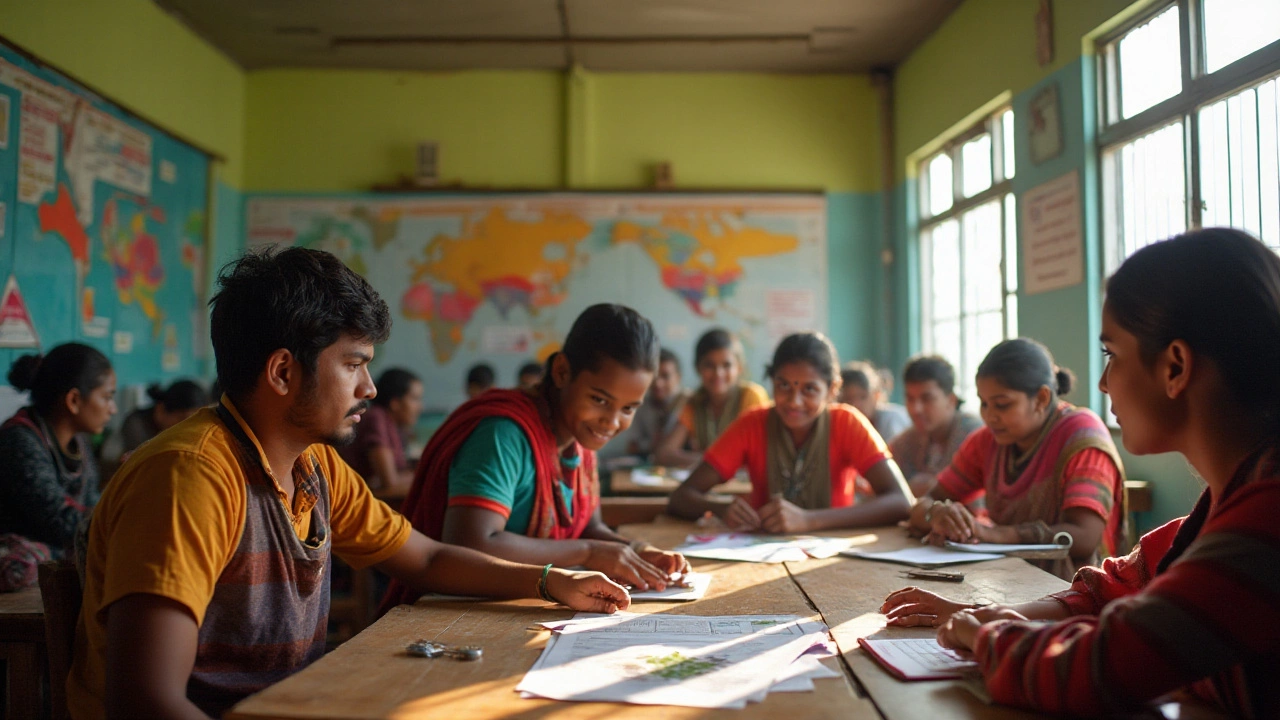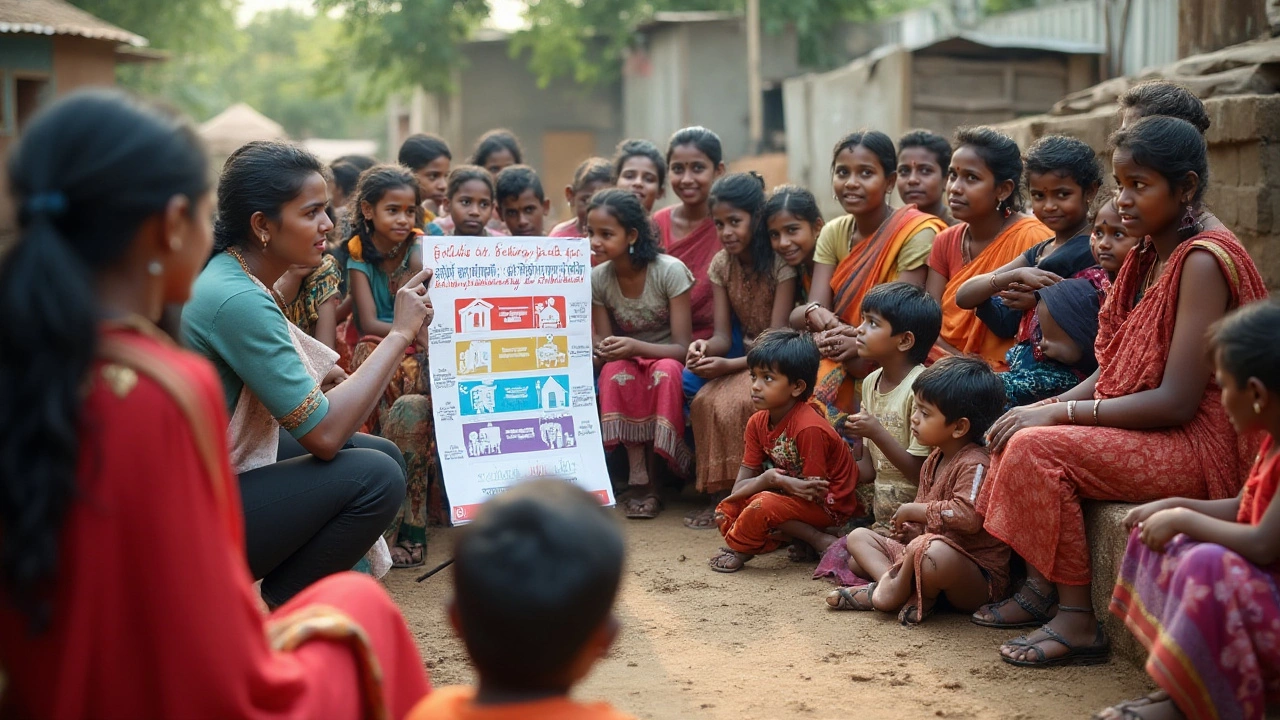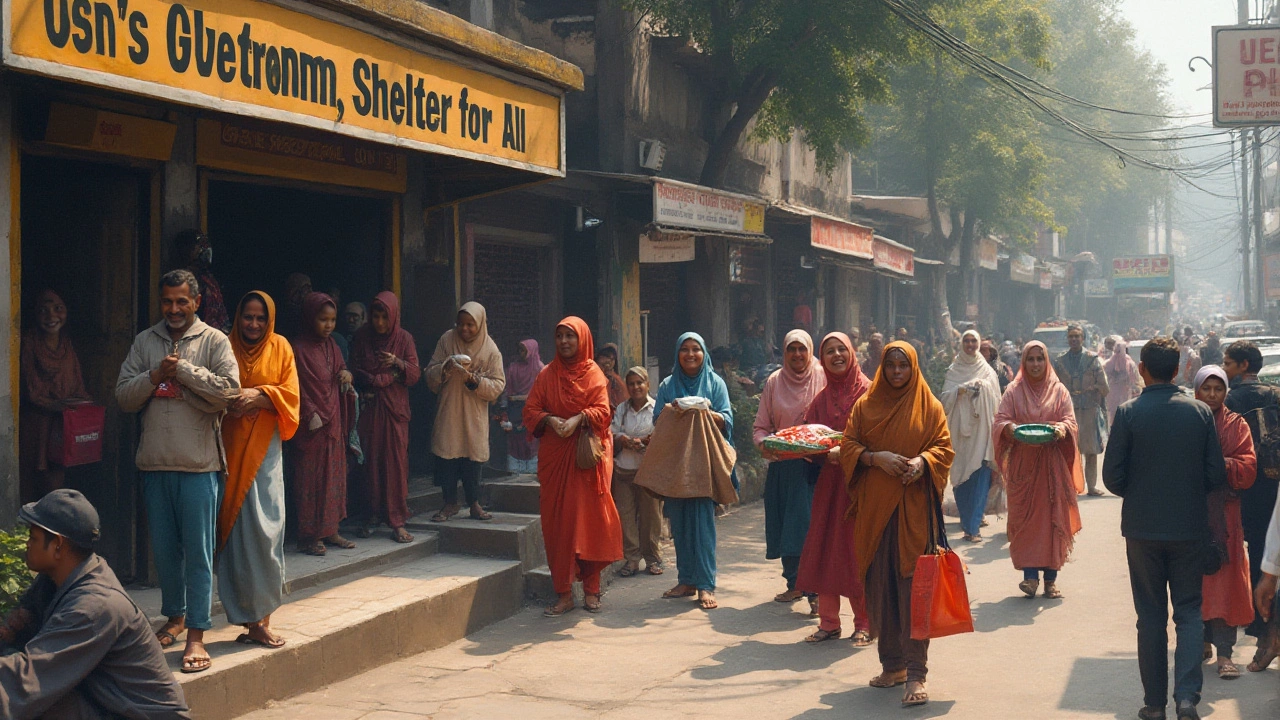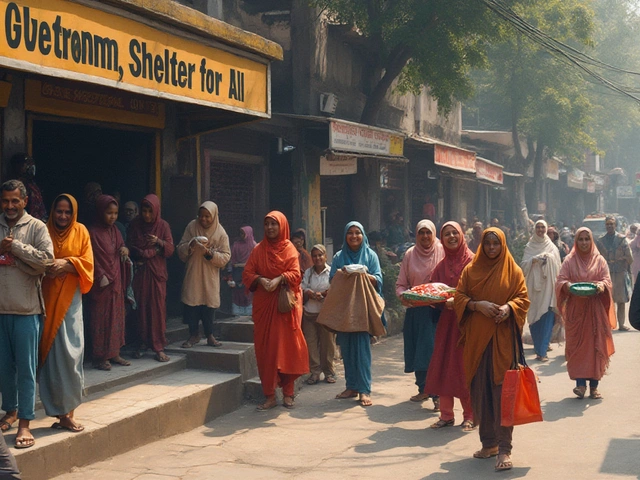In a rapidly growing nation like India, addressing the needs of the homeless has become a significant focus for the government. Various schemes have been launched, aiming to offer aid and enhance the quality of life for those without a steady roof over their heads. These initiatives go beyond mere handouts, striving to provide long-term solutions through skill development and vocational training.
The landscape of government support is multifaceted, touching on multiple aspects of homelessness, from providing temporary shelters to creating employment opportunities. While the intent and structure of these programs are robust, their effectiveness often hinges on proper implementation and awareness among the beneficiaries.
This article takes a closer look at the existing government schemes in India designed to support the homeless population, shedding light on the opportunities they present and the hurdles they face. By understanding these aspects, we can better appreciate the efforts made and consider what more can be done to alleviate homelessness in the country.
- Introduction to Government Schemes for the Homeless
- Current Initiatives and Their Objectives
- Impact and Benefits of These Schemes
- Challenges in Implementation
- Future Prospects and Recommendations
Introduction to Government Schemes for the Homeless
The journey towards a more equitable society in India has always been marked by efforts to help the country’s most vulnerable populations. Among these, the homeless, often seen lining bustling city streets or squatting under makeshift shelters, require urgent attention. Recognizing this profound need, the Indian government has rolled out several government schemes to address the critical issues faced by them. These efforts aim not only to provide immediate relief but also to empower individuals to reclaim their way to self-sufficiency.
One pioneering initiative is the 'Deendayal Antyodaya Yojana – National Urban Livelihoods Mission (DAY-NULM),' which places significant emphasis on reducing poverty and homelessness in urban areas. This scheme provides skill development and encourages entrepreneurship among the homeless, giving them tools to improve their lives long-term. It encompasses multiple facets such as conducting surveys to identify homeless individuals, providing shelters with essential services, and ensuring skill training for employment.
An integral part of this mission involves schemes in India that seek to reintegrate the homeless into the societal fabric through job opportunities. Skills taught include everything from tailoring to mechanics, aiming to match the learning with regional industry demands. This blend of direct aid and long-term solution represents a nuanced approach to tackling one of India's complex social issues.
The Indian government has also inaugurated the ‘Shelter for Homeless’ component under DAY-NULM, which focuses on creating secure, habitable spaces for people without homes. These shelters do more than provide a place to sleep; they also offer medical, psychological, and nutritional support, creating a foundation for these individuals to build upon. While statistics on exact numbers fluctuate, recent estimates indicate that these shelters have benefited hundreds of thousands of individuals, a testament to their importance.
Despite these schemes, challenges persist. Urban sprawl, a burgeoning population, and insufficient resources mean that many still slip through the cracks. A report by the Ministry of Housing and Urban Affairs noted that while significant strides have been made, sustained efforts and innovation in policy implementation are crucial to overcoming the systemic issues leading to homelessness.
“The real challenge lies in not just providing a roof,” remarked an official from the ministry, “but ensuring that the roof is a stepping stone to a better life.”
With these efforts, the government is carving pathways to better living standards. In doing so, it tackles a problem that is both a humanitarian need and a societal obligation. Thus, the story of India’s homeless and the schemes devised for their welfare is not just about aid but about fostering an ecosystem of hope. As we delve further into these initiatives, we must remember the human faces they aim to uplift and the shared dream of a world where everyone has a place to call home.
Current Initiatives and Their Objectives
The Indian government has rolled out an array of schemes to address the issues faced by the homeless and those seeking a way out of poverty. Notably, the ‘National Urban Livelihoods Mission (NULM)’ stands at the forefront of these initiatives, specifically targeting urban poverty alleviation by enhancing the skill sets and livelihood opportunities for the urban poor. This includes providing affordable shelters, making skill training accessible, and supporting self-employment ventures. The goal is not just to provide temporary aid but to empower individuals with the ability to sustain themselves in the long term.
An essential element of these initiatives is the homeless shelter provisions delivered through schemes like the ‘Shelter for Urban Homeless’. This program ensures that individuals and families living on the streets can access safe night shelters supplied with basic amenities. These shelters serve as a critical stopgap, offering rest and refuge to those struggling to make ends meet. The idea is to maintain a compassionate approach while simultaneously working towards reintegration into society. A government official was once quoted saying,
"A roof over one’s head is the first step towards rebuilding a life; it gives a sense of dignity and security."
The ‘Nai Manzil’ scheme is another remarkable initiative specifically directed towards the skill development of minority communities. It combines educational and vocational training altogether, ensuring that individuals not only become job ready but also possess the requisite knowledge to navigate various sectors. With its emphasis on community development, this program aims for an inclusive growth model, drawing on the philosophy of leaving no one behind. The impact of these skill enhancement programs is profound, as evident from measurable outcomes in areas where these programs have been effectively implemented.
Skill development programs also encompass collaborations with various corporate and non-profit organizations, which bring in additional expertise and resources. These collaborations enhance the scope of training, covering a wide range of industries including agriculture, manufacturing, and services. The government’s approach to leveraging partnerships amplifies the reach of these initiatives, creating a network of opportunities for beneficiaries. Data from recent reports suggest a notable increase in employment rates among participants of these programs, marking a positive trend in poverty reduction. Here's a snapshot of success stories:
| Initiative | Impact |
|---|---|
| Shelter for Urban Homeless | Over 100,000 individuals provided with safe shelter |
| Nai Manzil | 15% increase in employment for minority youth |
In striving to create comprehensive solutions, the government also invests in public awareness campaigns aimed at destigmatizing homelessness. These campaigns are crucial as they work in tandem with policy measures, shaping public perception and encouraging a sense of community support and participation. By creating a more educated and engaged citizenry, the ultimate goal is to nurture an environment where individuals in need are treated with empathy and are provided with opportunities to improve their life circumstances effectively.

Impact and Benefits of These Schemes
The government schemes for the homeless in India have manifested remarkable impacts both on individual lives and the community at large. By providing homeless support through shelters, these initiatives grant a sense of safety and stability to those who might otherwise be living on the streets. A significant benefit is the transition of individuals from dependence to self-reliance, facilitated by structured programs focusing on skill development. Such initiatives target the rescue and rehabilitation of beggars, offering a chance to learn basic life skills along with vocational training tailored to the needs of the labor market.
One notable effect of these programs is the reduction of visible homelessness in urban areas. This not only boosts community morale but also contributes to a cleaner, safer, and more vibrant city environment. An example of success is seen in the NULM (National Urban Livelihoods Mission) which has helped many beneficiaries secure employment, thereby transitioning from a life of uncertainty to one of hope and productivity. Studies have shown that employment significantly lowers the incidence of recurring homelessness, essentially breaking the cycle of poverty.
These government schemes in India not only provide immediate relief but also work towards long-term poverty alleviation. With the introduction of comprehensive rehabilitation programs, the focus has shifted to sustainable living solutions. This approach helps individuals regain their dignity and encourages them to become contributing members of society. A recent report highlighted that communities with active government intervention in homelessness showed better health and educational outcomes, showcasing a ripple effect where children of beneficiaries are more likely to stay in school and complete their education.
Community Involvement and Support
The involvement of local communities amplifies the benefits of these programs. Community partnerships established through these schemes increase their reach and effectiveness. Local NGOs often play pivotal roles in awareness campaigns and in implementing these programs on the ground. In many cases, these organizations act as the bridge between the government and the target audience, ensuring that the resources reach the rightful beneficiaries. A report on such collaborations noted, "Transformative change can only happen when the compassion of the community joins forces with structured governmental support."
These interaction points also help address specific local issues, creating customized solutions that fit distinct community needs, rather than a one-size-fits-all approach. In some areas, this might mean providing special training programs for women, or in others, tapping into the local artisanal skills and enhancing them for modern markets. By doing so, the schemes create a foundation for local economies to thrive, thus securing long-term benefits that go beyond immediate rescue efforts.
As new strategies continue to evolve, adapting to the changing socio-economic landscapes, the combination of poverty alleviation efforts with societal engagement marks a promising path forward for these government schemes. By fostering a culture of inclusivity and self-sufficiency, India strides towards a future where homelessness and begging are largely relics of the past.
Challenges in Implementation
While India has embarked on transformative journeys through various government schemes aimed at helping the homeless, the path is fraught with challenges that require nuanced understanding and resolution. One of the most pressing issues is the lack of awareness among the potential beneficiaries. Many homeless individuals are either unaware of the schemes available to them or have insufficient information to access these benefits. This gap in knowledge often stems from inadequate outreach and communication strategies, which need to be more comprehensive and perhaps culturally tailored to reach a diverse population spread across vast rural and urban landscapes.
Administrative hurdles also pose significant barriers to the effective implementation of these government programs. Bureaucratic red tape often results in delays and inefficiencies in service delivery. The absence of streamlined processes can deter those in dire need from availing themselves of essential services. This issue is compounded by the fact that the infrastructure required to support the execution of these schemes is not uniformly developed across the country. Disparities in infrastructure mean that while urban areas might have relatively better access to resources and facilities, rural and remote areas often lag far behind, leaving a large segment of the population underserved.
Another major challenge lies in coordination among various governmental bodies and non-governmental organizations (NGOs). The success of these schemes depends heavily on collaborative efforts, which are sometimes hindered by conflicting priorities or lack of adequate resource allocation. When different actors involved in the welfare ecosystem fail to synchronize their efforts, it leads to inefficient utilization of resources and a duplication of activities rather than complementary efforts. As noted by a senior official from a prominent NGO,
"Coordination is crucial, not just between departments but also with the grassroots organizations that understand local needs better. Without it, schemes lack the precision they require to make a real impact."
Societal perceptions and stigma towards homelessness also restrict the effectiveness of these poverty alleviation schemes. Often, homeless individuals face discrimination, which affects both their access to aid and the quality of support they receive. Addressing these deeply ingrained societal attitudes requires sustained efforts in education and advocacy, ensuring that compassion and understanding replace prejudice and neglect. In this context, community involvement becomes critical, as local groups can play a pivotal role in bridging the gap between policy and practice.
Furthermore, there are inherent difficulties in tracking progress and measuring outcomes of these schemes due to the dynamic nature of homelessness. Transient populations do not easily lend themselves to traditional methods of monitoring and evaluation. This makes it challenging to gather reliable data, assess the success of programs, and make evidence-based adjustments. Building a robust data collection framework that accounts for mobility and anonymity is essential to providing accountable and transparent feedback on these initiatives.

Future Prospects and Recommendations
The landscape of government schemes in India aimed at helping the homeless and destitute populations is evolving, promising a future where such initiatives might provide more transformative impacts. Currently, schemes like shelters and skill-building programs provide temporary assistance, but there is potential for expansion and innovation. A holistic approach could see these efforts integrated into broader social welfare and development strategies, ensuring that support extends beyond survival into meaningful change. Close monitoring and evaluation of existing schemes can reveal weaknesses, paving the way for adjustments that make them more effective.
One of the most promising prospects lies in integrating technology into these schemes. Digital platforms could streamline processes, making it easier for the government to track progress and make data-driven decisions. By leveraging mobile applications and databases, information dissemination can improve, reaching beneficiaries more effectively. Moreover, technological tools can facilitate skills training by offering online courses tailored to the needs of homeless individuals seeking employment.
There is also a growing recognition of the role of public-private partnerships in enhancing the effectiveness of these initiatives. Businesses can bring in resources, expertise, and innovative solutions, often with greater flexibility than government programs alone. Collaboration with non-profits and volunteer organizations can also play a crucial role, offering services that complement government schemes, such as mental health support and addiction recovery programs. To encourage such partnerships, policies could include incentives for companies that participate in welfare programs.
The World Bank remarks, "Collaboration between the government and private sector can harness innovative approaches to social welfare and scale up successful pilot programs."
A future-focused recommendation would emphasize community engagement at the grassroots level. By involving local leaders and beneficiaries in the planning and execution of welfare programs, these initiatives can be tailored to the unique needs of various communities. This involvement fosters trust and ensures that the voices of those directly impacted by poverty are heard and respected.
Strategic investment in capacity building and infrastructure is critical. Establishing more training centers focused on diverse skills relevant to today's job market could significantly reduce dependency on charity. Meanwhile, improving shelter facilities to include more comprehensive services, from healthcare to education access, can help create more sustainable outcomes. Policymakers would do well to incorporate feedback mechanisms, allowing beneficiaries to provide input on the effectiveness of services received.
Data-driven policy making backed by robust research is another area of opportunity. Collecting clear, comprehensive data on the performance of various schemes and the demographics of their beneficiaries can guide future developments. Such data allows for tailored interventions that account for regional variations and demographic needs.
| Initiative | Current Status | Goals |
|---|---|---|
| Beggars Welfare | Limited impact due to reduced awareness | Decrease homeless population by 20% by 2026 |
| Skill Development | Operational in urban areas | Expanding to rural zones |
| Public-Private Partnerships | At formative stages | Increase engagement by 50% in 5 years |
In the long term, a successful approach is proactive rather than reactive, addressing root causes to prevent homelessness before it begins. By combining efforts across government levels, engaging the private sector, and ensuring community involvement, the future of beggars welfare schemes in India can be both robust and compassionate. While significant efforts have been made, this journey demands continued innovation and commitment to keep moving towards a compassionate and equitable society.


